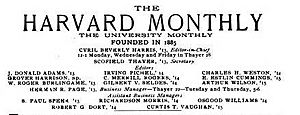E. E. Cummings facts for kids
Quick facts for kids
E. E. Cummings
|
|
|---|---|

Cummings in 1953
|
|
| Born |
Edward Estlin Cummings
October 14, 1894 Cambridge, Massachusetts, U.S.
|
| Died | September 3, 1962 (aged 67) Madison, New Hampshire, U.S.
|
| Alma mater | Harvard University |
| Occupation | Author |
| Signature | |
Edward Estlin Cummings (October 14, 1894 - September 3, 1962) was an American poet, painter, and writer. He is often known as E. E. Cummings. He wrote about 2,900 poems, several books, and plays. Many people consider him one of the most important American poets of the 1900s.
Cummings is known for his unique style of poetry. He often used unusual word order and sometimes wrote words in all lowercase letters. This made his poems look and sound different, almost like a picture.
Contents
Life of E. E. Cummings
Growing Up and School
Edward Estlin Cummings was born on October 14, 1894, in Cambridge, Massachusetts. His parents, Edward and Rebecca, were well-known in their community. His father was a professor at Harvard University and a minister. His mother loved playing games with Cummings and his sister, Elizabeth.
From a young age, Cummings' parents supported his creative side. He wrote poems and drew pictures as a child. He also loved playing outdoors with other kids in his neighborhood. Many summers were spent at Silver Lake in Madison, New Hampshire. His family later bought Joy Farm there, which became his main summer home.
Cummings wanted to be a poet since he was a child. He wrote poetry every day from age 8 to 22. He studied at Harvard University, earning his bachelor's degree in 1915 and his master's degree in 1916. At Harvard, he became interested in modern poetry, which often broke traditional grammar rules.
World War I Experience
In 1917, during World War I, Cummings joined the Norton-Harjes Ambulance Corps. He went to France and quickly fell in love with Paris. He would visit the city many times throughout his life.
While serving, Cummings and his friend William Slater Brown sent letters home that caught the attention of military officials. They were open about their anti-war feelings. Because of this, they were arrested by the French military in September 1917. They were held for about three and a half months in a detention camp.
Cummings' father worked to get him released. Cummings was set free in December 1917. His time in the camp became the basis for his book, The Enormous Room (1922). He returned to the United States in 1918 and later served briefly in the army.
After the War
Cummings returned to Paris in 1921 and lived there for two years. His first collection of poems, Tulips and Chimneys, was published in 1923. This book showed his unique use of grammar and punctuation. He quickly became known as a groundbreaking poet.
During the 1920s and 1930s, Cummings traveled a lot in Europe. He met famous artists like Pablo Picasso. In 1931, he visited the Soviet Union and wrote about his experiences in a book called Eimi. He also worked as a writer and portrait artist for Vanity Fair magazine.
In 1926, his parents were in a car accident. His father died, which deeply affected Cummings. This event led him to focus on deeper life meanings in his poetry. He honored his father in the poem "my father moved through dooms of love."
Later Life and Legacy
In 1952, Harvard University invited Cummings to be a guest professor. He gave a series of lectures that were later published as i: six nonlectures.
Cummings spent his last ten years traveling, giving speeches, and enjoying his summer home, Joy Farm, in Silver Lake, New Hampshire. He passed away from a stroke on September 3, 1962, at age 67. He was buried in Boston, Massachusetts. At the time of his death, he was one of the most widely read poets in the United States, second only to Robert Frost.
His writings and artworks are kept at the Houghton Library at Harvard University and the Harry Ransom Center at the University of Texas at Austin.
Personal Life
Relationships
Cummings was married twice, first to Elaine Thayer and then to Anne Minnerly Barton. His longest relationship was with Marion Morehouse, which lasted over 30 years.
His first marriage to Elaine Orr began in 1918. They had a daughter together. They married in 1924 but separated after only two months.
Cummings married Anne Minnerly Barton in 1929. They separated three years later in 1932.
In 1934, Cummings met Marion Morehouse, a fashion model and photographer. They lived together until his death in 1962.
His Work
Poetry Style
Even though Cummings was familiar with new and experimental styles, much of his poetry was quite traditional. Many of his poems are sonnets, which have 14 lines. He also used forms like the blues and acrostics.
Cummings' poems often explore themes of love, nature, and how individuals relate to society. He also used satire, which is a way of making fun of something to show its flaws.
His early work was influenced by poets like Gertrude Stein and Ezra Pound. Later, his visits to Paris introduced him to art movements like Dada and Surrealism. He started using more symbolism and allegory in his writing. Cummings also often included images of nature and death in his poems.
Some of his poems are free verse, meaning they don't follow strict rhyme or rhythm. However, many have a clear sonnet structure. A number of his poems have a very unique look on the page. Words, parts of words, or punctuation might be spread out. They might not make sense until you read them aloud, then their meaning becomes clear. Cummings was also a painter, and he used typography (the way words are arranged) to "paint a picture" with his poems.
Even as a child, Cummings showed his unique style. At age six, he wrote to his father:
FATHER DEAR. BE, YOUR FATHER-GOOD AND GOOD,
HE IS GOOD NOW, IT IS NOT GOOD TO SEE IT RAIN,
FATHER DEAR IS, IT, DEAR, NO FATHER DEAR,
LOVE, YOU DEAR,
ESTLIN.
After his book The Enormous Room, Cummings' first poetry collection was Tulips and Chimneys (1923). This book was the public's first look at his unusual use of grammar and punctuation.
Many of Cummings' most famous poems don't have much unusual typography. But they still show his unique style, especially in their interesting word order. Many of his poems also make fun of social issues.
Cummings also wrote books for children and novels. He even wrote an introduction for a collection of the comic strip Krazy Kat.
Plays
Cummings published four plays during his life. These include HIM (1927) and Santa Claus: A Morality (1946).
Art and Painting
Cummings was also a dedicated visual artist. He called writing and painting his "twin obsessions." He painted constantly from childhood until his death. He left behind more than 1,600 oil and watercolor paintings and over 9,000 drawings. He once said that his painting and writing "love each other dearly."
Cummings had over 30 art exhibits during his lifetime. He was praised as an American cubist and abstract painter between the World Wars. However, after his books The Enormous Room and Tulips and Chimneys were published in the 1920s, his fame as a poet became greater than his success as an artist. In 1931, he published a book of his artwork called CIOPW. The title came from the media he used: charcoal, ink, oil, pencil, and watercolor.
His Name and Capitalization
Cummings' publishers and others often wrote his name in lowercase letters, like "e. e. cummings." This was done to match the unusual way he wrote his poems. However, Cummings himself usually signed his name with capital letters.
The idea of using lowercase for his name became popular partly because some book covers in the 1960s printed his name in lowercase. But Cummings' widow said this was incorrect. She stated that Cummings preferred his name to be capitalized. When he did sign his name in all lowercase, it might have been a sign of humility, not a rule for others to follow.
Works Adapted by Others
Many artists have used Cummings' poems in their own work.
- In 1943, dancer Jean Erdman created a dance piece using his poem "Forever and Sunsmell." She also choreographed "Twenty Poems" in 1960.
- Many composers have set Cummings' poems to music. These include Pierre Boulez, Morton Feldman, and Eric Whitacre.
- The Icelandic singer Björk used lines from his poems "I Will Wade Out" and "It May Not Always Be So" for songs on her albums Vespertine (2001) and Medúlla (2004).
- Other composers who have used his poems include Leonard Bernstein, John Cage, and Aaron Copland.
Awards and Recognition
Throughout his life, Cummings received many awards for his work:
- Dial Award (1925)
- Guggenheim Fellowship (1933, 1951)
- Shelley Memorial Award for Poetry (1945)
- Harriet Monroe Prize from Poetry magazine (1950)
- Fellowship of American Academy of Poets (1950)
- Charles Eliot Norton Professorship at Harvard (1952–1953)
- Special award from the National Book Award Committee for his Poems, 1923–1954 (1957)
- Bollingen Prize in Poetry (1958)
- Boston Arts Festival Award (1957)
- Two-year Ford Foundation grant of $15,000 (1959)
|
See also
 In Spanish: E. E. Cummings para niños
In Spanish: E. E. Cummings para niños




